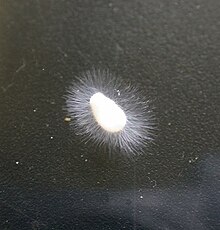| Achlya | |
|---|---|
 | |
| Mainly Achlya sp. Isolated from small stream around rice field. Incubated in room temperature on hemp seed | |
| Scientific classification | |
| Domain: | Eukaryota |
| Clade: | Diaphoretickes |
| Clade: | SAR |
| Clade: | Stramenopiles |
| Phylum: | Oomycota |
| Order: | Saprolegniales |
| Family: | Saprolegniaceae |
| Genus: | Achlya |
Achlya is a genus of oomycete (water mold), in the family Saprolegniaceae. The genus includes several plant pathogens including Achlya conspicua and Achlya klebsiana . Unlike many other microorganisms, cell expansion is governed by changes in cell wall strength rather than changes in osmotic pressure. [1] The genome of Achlya hypogyna has been sequenced and can be accessed on public online databases, for example on the NCBI website (National Center for Biotechnology Information). [2]
Contents
The genus was first circumscribed in Nova Acta Phys.-Med. Acad. Caes. Leop.-Carol. Nat. Cur. vol.11 on page 514 in 1823 by Christian Gottfried Daniel Nees von Esenbeck. [3] [4]
The type species is Achlya prolifera . [3]
The genus name of Achlya is named after Achlys, who in the Hesiodic Shield of Heracles , is one of the figures depicted on Heracles' shield, perhaps representing the personification of sorrow. [5]
Several Achyla spp. are pathogens of rice seedlings. [6]
